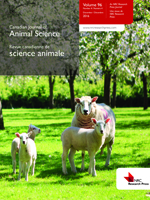Li, S., Khafipour, E., Krause, D. O., González, L. A. and Plaizier, J. C. 2011. Effects of grain-pellet and alfalfa-pellet subacute ruminal acidosis (SARA) challenges on feeding behaviour of lactating dairy cows. Can. J. Anim. Sci. 91: 323-330. The effects of two nutritional challenges aimed at inducing subacute ruminal acidosis (SARA) on the feeding behaviour of lactating dairy cows were investigated in two separate experiments. Both experiments included eight tie-stall-housed cows that were fed once daily. Feeding behaviour of individual cows was monitored by continuously weighing the feed in the mangers. In each experiment, ruminal pH was monitored in four rumen cannulated cows. In the first experiment, cows received a control diet containing 50% mixed concentrate and 50% alfalfa and barley silage (DM basis) during weeks 1 to 5 of two subsequent 6-wk periods. During week 6 of both periods, a grain-pellet SARA challenge (GPSC) was conducted by replacing 21% of DM of the basal diet with wheat-barley pellets. Data obtained in week 4 were taken as a control. In the second experiment, cows received a control diet containing 50% of DM as mixed concentrate and 50% of DM as chopped alfalfa hay during the first week of a 5-wk period. Between week 2 and week 5, an alfalfa-pellet SARA challenge (APSC) was conducted by replacing alfalfa hay in the control diet with alfalfa pellets at a rate of 8% per week. Week 1 and week 5 were considered as the control and SARA challenge, respectively. In the first experiment, the GPSC reduced the meal duration from 48.9 to 38.6 min meal-1 and the eating time from 6.7 to 5.5 h d-1. Meal criteria, meal frequency, meal size, and eating rate were not affected. In the second experiment, the APSC did not affect the meal criterion, meal duration, and eating time per day, but increased dry matter intake from 18.7 to 24.3 kg d-1, meal frequency from 8.2 to 9.4 meals d-1, meals size from 2.4 to 2.7 kg DM, and eating rate from 54.8 to 67.6 g DM min-1. The duration of the first meal after feed delivery was reduced from 154.5 to 103.6 min by the GPSC and from 146.7 to 112.2 min by the APSC. This reduction in the duration of the first meal was accompanied by a reduction in the drop of the ruminal pH during the GPSC, but not during the APSC. Only the APSC increased eating rate of the first meal. Other parameters of this first meal were not affected by both challenges.
How to translate text using browser tools
1 June 2011
Effects of grain-pellet and alfalfa-pellet subacute ruminal acidosis (SARA) challenges on feeding behaviour of lactating dairy cows
S. Li,
E. Khafipour,
D. O. Krause,
L. A. González,
J. C. Plaizier
ACCESS THE FULL ARTICLE
It is not available for individual sale.
This article is only available to subscribers.
It is not available for individual sale.
It is not available for individual sale.

Canadian Journal of Animal Science
Vol. 91 • No. 2
June 2011
Vol. 91 • No. 2
June 2011
acidose subaigüe du rumen
Dairy cow
feeding behaviour
habitudes alimentaires
subacute ruminal acidosis
vache laitière




